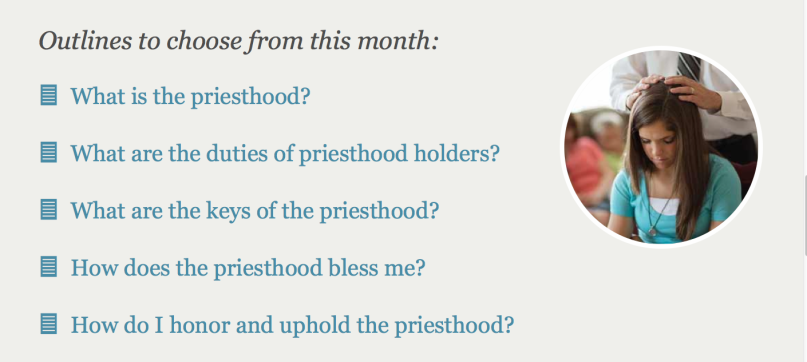
(Screen shot of this month’s YW curriculum from https://www.lds.org/youth/learn/yw/priesthood-keys?lang=eng.)
Today over at Doves & Serpents there’s an excellent blog post on the challenge of teaching the Young Women this month from the new curriculum. Every week in June, in both their Sunday School lessons and their YW lessons, the girls are supposed to learn about the priesthood.
I am generally a fan of the new curriculum, which is a great improvement over what the youth had before. And on the one hand, I feel that it is important for lessons like “Duties of Priesthood Holders” to teach YW what their YM counterparts are actually doing, and to give them a deeper understanding of how leadership functions. I also think that the suggested outline on “How can I participate effectively in councils in the Church?” is a step in the right direction, teaching girls alongside boys that their opinions matter and they should speak up.
But on the other hand, this month’s exclusive focus on priesthood brings into sharp relief some of the gender issues in the Church, problems that a blogger at Zelophehad’s daughters memorably called “chicken patriarchy” in 2007. “Chicken patriarchy” is what happens when unequal power structures that preclude female authority remain in place even as an institution espouses rhetoric in which women are referred to as equal partners in leadership. Chicken patriarchy changes its rhetoric to suit the climate, which can be confusing when church leaders now refer to women as equals but uphold a system that does not give them the same opportunities for leadership and growth as men. The post summarized this conundrum well:
In the past, the waters were less muddied: husbands were granted divine authority over their wives, who were required to submit to their righteous leadership–-an objectionable stance, perhaps, but not an inconsistent one. In the present, the Church has adopted a new stance but without giving up its old one: now wives not only submit, but they are also equal partners.
In chicken patriarchy fashion, this month’s lesson on “How does the priesthood bless me?” encourages the YW to reflect on how they have been blessed by the priesthood, but this is always as recipients, not as full participants. A Mormon woman’s lifelong relationship to priesthood might be described as follows:
A priesthood holder blessed me when I was an infant, baptized and confirmed me when I turned eight, endowed me in the temple, served as my mission president, performed my temple marriage, assessed my worthiness, authorized my temple recommends, decided upon and set me apart for all my callings in the church, presided over every sacrament meeting I ever attended, gave 95% of all General Conference talks, blessed me with healing oil whenever I was sick, conducted my funeral, and consecrated my grave.
In other words, the duties of a priesthood holder are to live out resumé-quality active verbs. The Young Women’s manuals this month highlight the passivity of the women’s expected relationship to this activity.
Many defenders of this system have been anxious to reassure women and girls that even though they don’t hold the priesthood they can still enjoy the full blessings of the priesthood. Such is the argument in this passage from Sheri Dew, which the YW are asked to discuss:
Sisters, some will try to persuade you that because you are not ordained to the priesthood, you have been shortchanged. They are simply wrong, and they do not understand the gospel of Jesus Christ. The blessings of the priesthood are available to every righteous man and woman. We may all receive the Holy Ghost, obtain personal revelation, and be endowed in the temple, from which we emerge ‘armed’ with power. The power of the priesthood heals, protects, and inoculates all of the righteous against the powers of darkness. Most significantly, the fulness of the priesthood contained in the highest ordinances of the house of the Lord can be received only by a man and woman together.
I appreciate the desire to make women feel included here, but such a statement is predicated upon a consumerist mentality that assumes it is better to receive than to give. As much as I respect Sister Dew and all that she has accomplished, I disagree with her approach here. Priesthood is not merely about being on the receiving end of divine power, or about obtaining blessings; it is a school for learning how to be like God. The exercise of priesthood is itself the greatest blessing of priesthood.
One final word on this month’s YW manuals. Priesthood and motherhood are equal, or so we are often told. We can test whether that rhetoric is really true by devoting the entire month of June to teaching the YM about motherhood while the YW are learning about priesthood. Motherhood, for five straight Sundays:
- What is motherhood?
- What are the duties of mothers?
- What are the keys of motherhood?
- How does motherhood bless me?
- How do I honor and uphold motherhood?
I would pay good money to see that.





